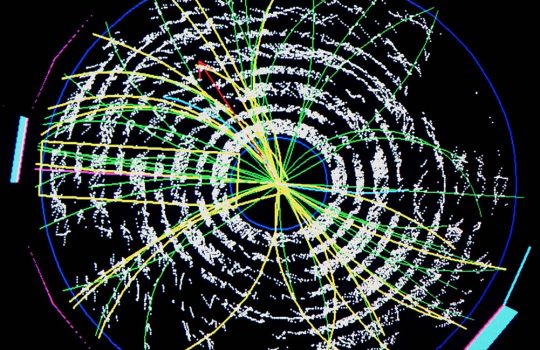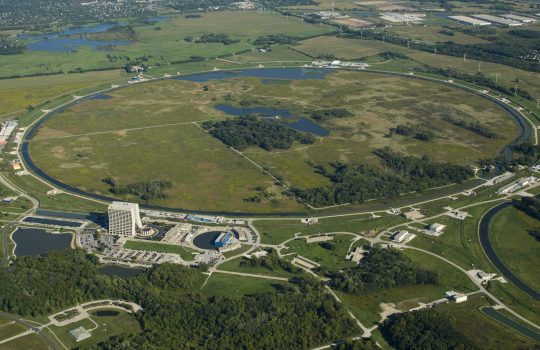An article to appear in the February 9 issue of Science describes results contained in a paper submitted to Physical Review Letters by the 450-member Collider Detector at Fermilab collaboration. The CDF paper reports results that appear to be at odds with predictions based on the current theory of the fundamental structure of matter. The paper, submitted January 21, reports the collaboration’s measurement of the probability that the fundamental constituents of matter will be deflected, or will “scatter,” when very high energy protons collide with antiprotons, according to CDF spokesmen William Carithers and Giorgio Bellettini.
The experimenters found that the probability of particle scattering for the most violent collisions is significantly higher than that predicted by current theoretical models. Collaborators believe that more studies of both experimental data and theoretical analyses will show whether relatively small adjustments to theory can reconcile the discrepancy between the theory and the recent measurements; or whether the data are the first hint that the fundamental constituents of matter may not be fundamental after all.
The atomic nucleus is made of neutrons and protons. The current theory of the structure of matter holds that the subatomic particles known as quarks are the smallest fundamental building blocks of the proton. The first evidence that protons were made up of quarks came in the late 1960s, when very high energy electrons scattered off protons more violently than experimenters expected. Evidence over the last quarter century, including the discovery of the top quark at Fermilab in 1995, has provided strong confirmation of the quark theory of the structure of matter, in which the force-carrying particles called gluons bind the quarks together to form the proton.
The CDF researchers used the world’s highest-energy particle beams to probe deep inside the proton’s structure to the smallest distances yet explored. They found that the data from this exploration agreed very well with current theory at distances of about 100 times to about 1000 times smaller than the proton. However, beyond about 1/1000th the size of the proton, the data began to diverge from the theory.
One prosaic explanation for the observed discrepancy is that the quark-gluon mixture that makes up the proton shares the momentum of the proton in such a way that one piece carries a larger fraction of the momentum than previously believed. This interpretation would need to be reconciled with a large body of data from many other experiments. A second, more exciting, possible interpretation is that the quarks themselves are made up of something smaller still-a whole new level in the makeup of matter. The experimenters need to study other aspects of their data in order to say more about which, if either, of these interpretations is correct.
The CDF physicists carried out their experiments over the past two years at Fermi National Accelerator Laboratory’s Tevatron Collider, the world’s highest energy particle accelerator. Fermilab is a Department of Energy national laboratory, 30 miles west of Chicago. The CDF collaboration consists of physicists from 35 institutions in 14 states and five countries from around the world.
The CDF experiment is similar in spirit to the historic experiments of Sir Ernest Rutherford. In 1909, students in his laboratory directed alpha particles from a lump of decaying radium at sheets of gold foil. The unexpected way the particles scattered when they hit the foil led Rutherford to the discovery of the atomic nucleus in 1911. In a high-energy parallel, the CDF experiment looks at scattering in collisions between protons and antiprotons with energies more than 100,000 times higher than Rutherford’s projectiles. The higher energies allow CDF to probe structures much smaller than the atomic nucleus, down to the level of the quarks and gluons.
To study how the quarks and gluons behave, physicists use very high energy accelerators that act like powerful microscopes to allow researchers to “peer” inside the proton. Ordinary optical microscopes can only resolve, or see, objects larger than the wavelength of light, about the size of a small speck of dust. Electron microscopes accelerate electrons to scatter off much smaller objects and can “see” structures about 1000 times smaller. It is a fundamental principle of physics that higher energy transfers are required to probe, or “see,” smaller objects. Since the Fermilab accelerator has the world’s highest energy, it can probe the smallest distances.
Two years ago, the same CDF collaboration at Fermilab announced the first evidence for the top quark, the last quark to be discovered of the six predicted by current theory. The top quark completed the current theoretical picture of the fundamental structure of matter. Further research will show whether the picture needs repainting, or requires only a slight adjustment to the frame.
A Fermilab preprint of the paper, “Inclusive Jet Cross Section in pbar p Collisions at sqrt s = 1.8TeV,” appears on the World Wide Web at URL: http://www-cdf.fnal.gov/physics//pub96/pub96.html



